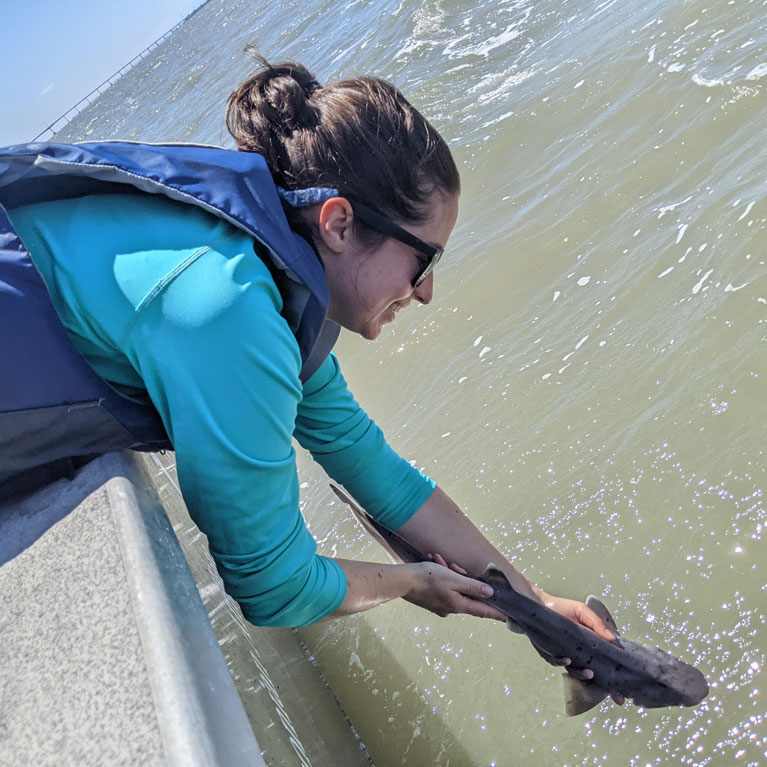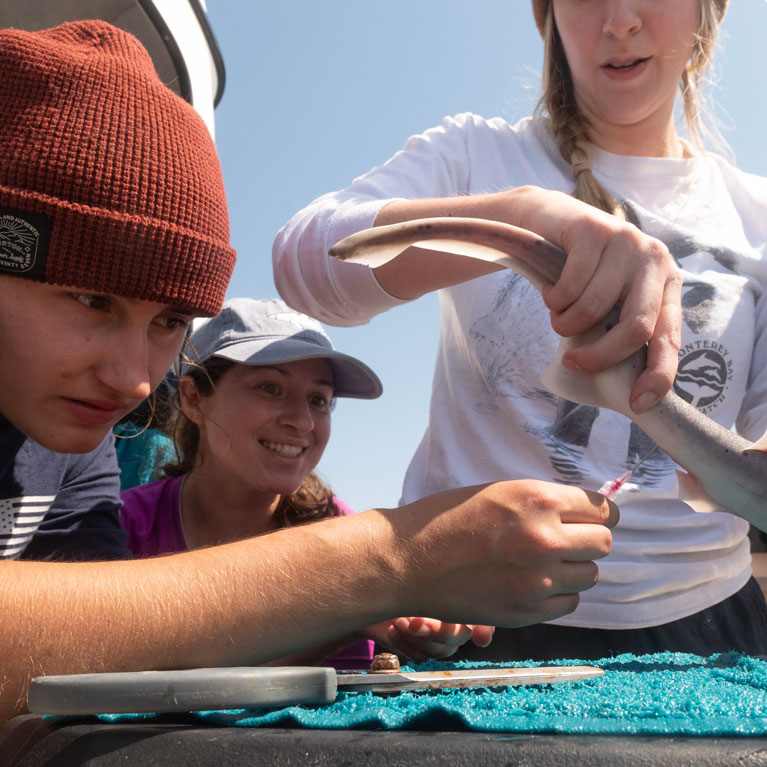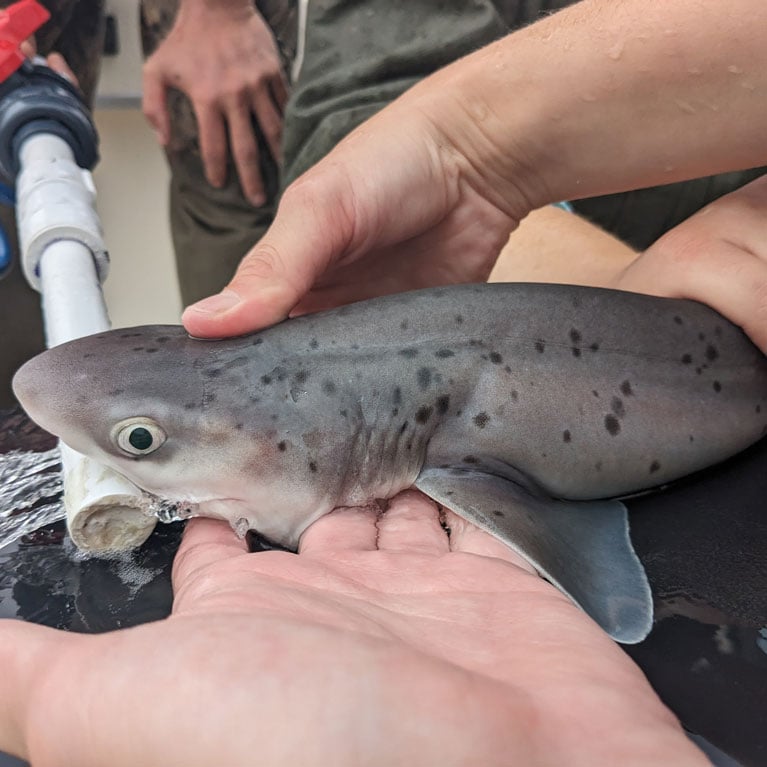Sevengills sharks in San Francisco Bay
Meghan wants to know all about sevengills in San Francisco Bay: what they’re eating at different ages and life stages, where they’re spending their time, and whether they are stressed by handling in the recreational catch-and-release fishery. Answering these questions will help her inform their ability to survive and thrive after being handled, whether there are any threats to their particular dietary needs at vulnerable stages in their life, and what the ecosystem that they most need looks like. Ultimately, this project will help inform fisheries management and hopefully better protect sevengill sharks on the Eastern Pacific coastline.
I grew up along the west coast of the USA and have always been intrigued by the diverse marine life that inhabits cold-water ecosystems. Having worked at non-profit aquariums for much of my early career, I have been greatly inspired by the unique aspect of conducting science at a facility where the conservation efforts can be directly communicated with the general public. Engaging the public in local conservation is a critical aspect of science, as it enables all stakeholders of management practices to be properly incorporated. With this in mind, I was determined to learn how to maximise public aquarium...



Conservation evaluation for the unregulated and vulnerable apex predator, the broadnose sevengill shark, Notorynchus cepedianus
To investigate what juvenile broadnose sevengill sharks require to reach adulthood by evaluating their dietary needs and their ability to survive catch-and-release fishing and by identifying critical habitat for them in San Francisco Bay. The results of this research will assist our understanding of what is required for fisheries management for the species and will contribute to its continued survival.
Targeted fishing for broadnose sevengill sharks in the only known place where juveniles aggregate, with little understanding of its impact, poses a direct threat to the population. An apex predator along the eastern Pacific coast, the broadnose sevengill shark migrates from Alaska to Baja California, Mexico. Understanding human-influenced impacts on the species is critical to its persistence, as is identifying what juveniles need to survive, and thrive, to adulthood.
The broadnose sevengill shark Notorynchus cepedianus is one of the largest apex predators along the eastern Pacific coast, particularly in bays and estuaries. The most recent assessment by the IUCN has re-assigned the species from Data Deficient to Vulnerable on the organisation’s Red List, which indicates a clear need to evaluate the threats to this population, whose range extends from South-east Alaska to Baja California, Mexico. The species’ requirements for reproductive and pupping grounds are very specific and the only documented breeding ground for this population is in Willapa Bay, Washington. In summer individuals migrate to San Francisco Bay, which is the only known pupping and nursery ground. Humboldt Bay, on California’s North Coast, was previously also known to be a pupping ground, but recent stock assessments there have shown that broadnosed sevengill sharks are no longer regularly present.
For the population to continue, it is vital that vulnerable sevengill pups survive. Little is known about the factors that influence juvenile behaviour, migration and attainment of sexual maturity. Because this species is slow-growing and is thought to have long generation times, it is particularly vulnerable to disturbances and stress in its pupping grounds, including those caused by overfishing. The active, targeted fishing of sevengills in their pupping grounds in California poses a direct threat to the survival of the entire eastern Pacific population, particularly in view of the fact that we know so little about their conservation needs.
The information required to resolve these concerns includes an evaluation of sevengills’ prey preferences and their ability to survive catch-and-release fishing; and an understanding of their movement patterns and site fidelity, from which we can deduce the importance of certain locations for reproduction or feeding, or the survival of neonates, juveniles and adults.
- To assess the stress response to catch-and-release fishing of juvenile sevengill sharks. This information will enable us to evaluate whether recreational fishing has an impact on the fitness of sevengills and therefore their ability to survive and thrive to adulthood if they are released after being handled.
- To identify the dietary needs of each size class of the sevengill shark. These needs will be evaluated at each age stage to discover shifts in diet as the sharks grow, as well as potential threats to food sources in the pupping and nursery grounds.
- To identify critical habitat for juvenile sevengills in San Francisco Bay. Although we are documenting how long juveniles remain in the bay, we do not yet know how they partition space. Insights into niche habitats will give us a better understanding of what they need.
Public presentation at MODS: Save Our Seas Distinguished Speaker Series: Sevengill Sharks Residing in San Francisco Bay
Summary of main research results/outcomes
San Francisco Bay is a critical nursery area for sevengill sharks (Notorynchus cepedianus). Stable isotope analysis confirmed that juvenile sevengill sharks exhibit long-term residency in the bay. This, with repeated sampling over multiple years, supports that San Francisco Bay meets all three established criteria for nursery habitats: higher juvenile abundance compared to other areas, extended use by juveniles, and consistent utilization across years.
Juvenile sevengill sharks exhibited physiological effects during 30-minute catch-and-release stress events, though their responses were less pronounced than those of more sensitive shark species. This suggests resilience to such fishing practices, providing valuable insights for fisheries management.
San Francisco Bay qualifies as an ‘Essential Fish Habitat’ (EFH) for sevengill sharks. Protecting this critical area is essential to support population sustainability, particularly if declines occur. These findings emphasize the ecological importance of San Francisco Bay and inform conservation strategies for this species.
Outputs / Media / Communication
Media Reuters highlighted this research September 14, 2023: https://www.reuters.com/science/san-francisco-bay-ecologists-work-protect-sevengill-sharks-2023-09-14/

